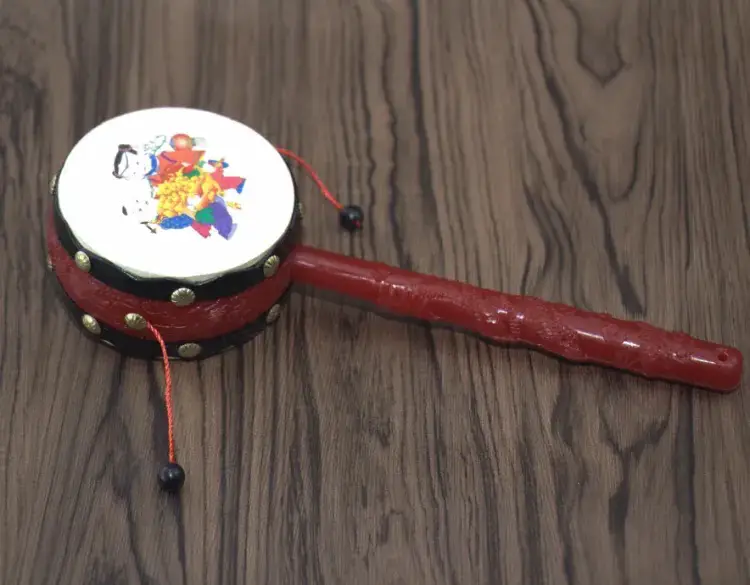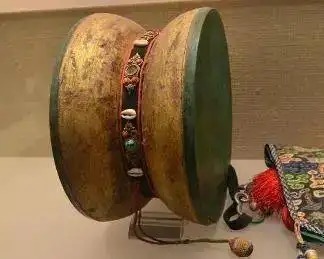China is a country known for its rich history in so many things such as outfits, dances, music, and cuisines. China has also been the origin of many instruments, the rattle drum in this case. The Chinese rattle drum is an ancient instrument that evolved through the years and became more than just a musical instrument in China. It can be used as a toy for toddlers and is also used as a noise-making object for Chinese peddlers to attract customers. As you can see the object is quite versatile. It is also very simple to make at home, therefore it is highly used in arts and crafts projects by children. This boosts their creativity and artistic skills as well as provides them with a toy to play with later. As you can see, as much as the object is a toy, it can be useful for anyone interested in it regardless of their age.
What is a Chinese rattle drum?

The Chinese rattle drum, known as the Bo Lang Gu in Chinese is one of the oldest and most traditional toys in China. It is a miniature double-sided drum with a handle, two strings tied to either end of the edge, and a wooden ball to beat the drum. When it is swayed, the balls on each side will beat the drum, sending out rhythmically rattling sounds.
Chinese rattle drum history
The Chinese rattle drum originated in China, with its earliest form being used as a percussion instrument during the Warring States Period. It was used to harmonize with other instruments in musical pieces most commonly in religious celebrations and banquets. In the Song Dynasty, the rattle drum became common during rites, business activities, and music. One of the best things about the rattle drum was its sound effect and recreational function and this prompted the instrument to become a toy for children making it even more popular.
Why is the rattle drum important?

The Chinese rattle drum has been used for years for celebrations, as toys, and as noise-making devices used by Chinese peddlers to draw attention. The rattling sound of the drum creates a happy, fun, and relaxed atmosphere that drums up business when it is shaken. Music is an integral part of Chinese culture and the rattle drum is played at the Chinese Lantern Festival in addition to other instruments. The rattle drum comes in handy when raising a toddler since the rattling sound can be used as a distraction. The instrument is also quite small so your toddler can hold and play it himself or herself.
What is the rattle drum made out of?
The Chinese rattle drum is can be made out of different things depending on the person who has crafted it. Some are wooden while others are plastic. Essentially, the instrument or toy has a wooden handle and two pennies, small bells, or beads dangling from the side. You can decide on the material you want based on personal preference. The “drums” can be made from paper plates or plastic.
How to make a rattle drum?
Someone might think that because the rattle drum is a well-known toy or instrument, the only way to get your hands on it is by purchasing it. While it’s true that the rattle drum is sold in various places, you can also get creative and make one yourself. It’s a very simple and fun process and anyone can do it. The best part about making one yourself is you can customize it how you want by using your favorite color and making the size you want. It can also be a bonding moment for you and your child as you make it together. Here are the steps to make a rattle drum:
Items needed
- 2 white paper plates
- 2 small bells/beads/pennies
- Craft glue
- 2 red packets
- Long wooden stick
- A loaded stapler
- Masking tape
- Ribbon
Instructions
- Paint the underneath of the two white paper plates with red paint and let it dry. You are not limited to red paint only. You can also use black, gold or a mixture.
- Apply the craft glue to the back of a red packet and stick it to the red painted surface of one plate. Ensure the printed side shows against the red.
- Flip over the paper plate to show the unpainted white side, and attach a ¼ of the wooden stick along the center of the paper plate with masking tape.
- Cut two equal lengths of ribbon (preferably red), tie the small bell/bead/penny to one end of each ribbon and then attach the free (bell-less) end towards the edge of the paper plate, about at the diameter.
- Cover the assembly with another paper plate. Make sure the two paper plates are aligned and secure them with staples at regular intervals around the edges of the plates. Staple twice at the ribbons and near the stick for reinforcement.
- Paste the second red packet on the plain red surface to complete the instrument. Let it dry thoroughly.
Why make the rattle drum?
Maybe you’re a parent whose child is asking for a Chinese rattle drum so you stumbled across this article as you tried to figure out everything about this instrument. The good news about the rattle rum is that you can make it yourself and give it to your child. Better yet you can guide your child to make it himself or herself! You might enjoy making it more than purchasing it.
Like we said earlier, crafting the DIY rattle drum can be a good bonding experience with your child. However, there are other numerous benefits of allowing your toddler to make one himself or herself. The most obvious one is that making it allows your child to creatively express himself or herself and boost creativity by picking the colors and customizing the toy. As you craft the instrument with your toddler, it allows him or her to feel that her input is valued and this will increase your child’s self-esteem and sense of self-worth. This will also give you tips for future gifts since you will take note of your child’s favorite colors. As your child paints the plates, the fine motor development is boosted through painting and other activities that encourage coordination of small muscles in movement with the eyes, fingers, and hands.
Conclusion
The Chinese rattle drum can be used in so many ways and it isn’t limited to musicians only. Purchase or craft one for your business or as a gift to your toddler. Don’t forget to appreciate its interesting history as you play it!